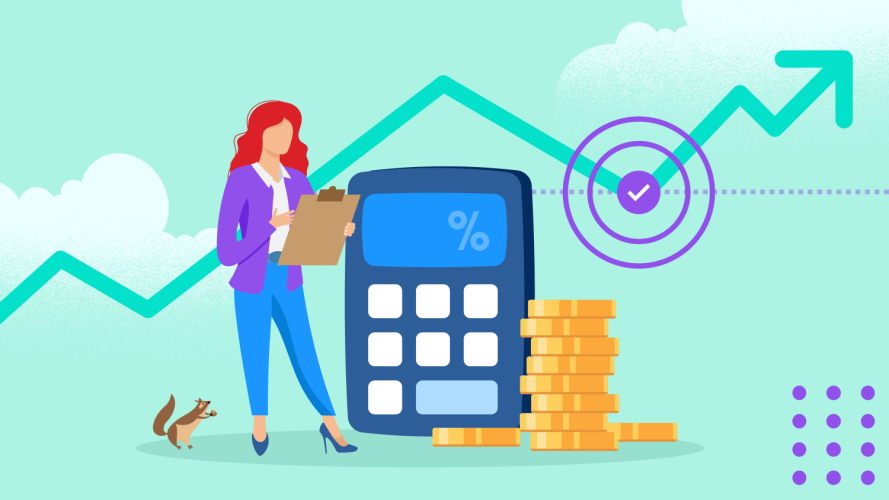Average Deal Size: The Secret to Forecasting with Confidence

Learn how to accurately calculate the average amount of your sales org's deals so you can create sales strategies that fuel growth.
Any salesperson with a few years under their belt knows that sales ebbs and flows. Sometimes, there are big waves — that’s good for business, and it’s good for commission. Other times, it’s hard to hook buyers and quota is out of reach. How do you forecast revenue with these ups and down? Simple: average deal size.
Below, we’ll walk through how to calculate this critical metric, ways to use it, and how to increase it — so those forecasts and commission checks are easier to count on.
What you’ll learn:
- What is average deal size?
- Why is average deal size important?
- What you need to know before calculating
- How to calculate
- How do companies use average deal size as a KPI?
- Impacting factors
- How to increase average deal size
Motivate your team with transparent incentive pay
Discover the power of automating commissions with Salesforce Spiff, and easily create incentive programs that scale.



What is average deal size?
Average deal size, sometimes called average order size, is a key metric organizations use to measure the average value of a company’s deals or sales transactions. This metric is used to analyze and forecast the revenue of a company as well as to understand a sales team’s performance. It can vary from industry to industry and company to company.
Why is average deal size important?
This key metric helps sales leaders measure the health of their teams and company. A higher average deal amount indicates that the sales team is closing larger deals, resulting in increased revenue for the company. By contrast, analyzing a low average can help companies identify areas for improvement in their sales process — particularly if measured over time.
What you need to know before calculating
Because an accurate average deal size is dependent on things like closed-won opportunities and average discounts, companies must ensure the accuracy of their sales data. The best way to do this is to make sure every rep is using the same source of truth (a robust CRM) and updating it regularly.
Companies should also consider analyzing the average deal amount in conjunction with other sales metrics such as win rate, sales cycle length, and customer lifetime value. Analyzing these metrics together can provide a more comprehensive understanding of sales performance and help identify areas of improvement.
Lastly, it’s important to keep in mind that the average deal size can vary depending on the industry and the type of product or service being sold. Therefore, companies should benchmark their average deal size against their competitors in the same industry to gain a better understanding of their performance.
How to calculate
Calculating average deal size is relatively straightforward — you just need to know how much revenue you’ve generated as an organization and the number of deals your team has closed during the given time period. The average deal size formula looks like this:
Average deal size = Total revenue generated / Total number of closed-won deals
For example, if a company generates $500,000 in revenue by closing 50 deals, the average order size would be $500,000/50, or $10,000.
How do companies use average deal size as a KPI?
Companies use average deal size as a key performance indicator (KPI) to measure sales performance and forecast future revenue. An increase indicates that the sales team is closing larger deals, which ultimately increases the company’s revenue. This KPI helps companies make data-driven decisions about sales strategies and budget allocation.
Impacting factors
Several factors can impact how big or how small a company’s average deal is:
- Product mix: If a company has a product portfolio with a wide range of products, the average deal size may vary depending on the mix of items customers purchase. Conversely, a company with a narrower product portfolio may have a more consistent average deal size. The more expensive the product range, the higher this KPI will be.
- Sales cycle: A longer sales cycle may indicate that the sales team is working on larger deals that take more time to close. This can result in a higher average deal size. This is something typically seen at SaaS companies.
- Target market: If a company focuses on selling to enterprise-level customers, the typical deal size may be higher than that of a company that focuses on selling to small and medium-sized businesses.
How to increase average deal size
Businesses can increase average deal size in a few different ways. Here are just a few:
- Consider upselling and cross-selling: Look for opportunities to offer additional products or services to your existing customers. This can be achieved by suggesting related or complementary products, or by offering upgrades to existing services.
- Use value-based pricing: Shift the focus from the price of the product or service to the value it provides. Highlight the benefits and the unique value proposition of your offering to justify a higher price.
- Price in bundles: Offer bundled packages that provide more value for a higher price. This approach works particularly well if you can offer packages that are more cost-effective than purchasing each item individually.
- Practice strategic positioning: Position your products and services as premium or exclusive and highlight their unique features and benefits. This can help you command a higher price for your offerings.
- Target higher-value customers: Focus on acquiring high-value customers who have a greater willingness to pay for your products or services. This can be achieved through targeted marketing campaigns, account-based selling, and other strategies.
- Increase customer loyalty: Invest in training your sales reps to build strong relationships with your existing customers. This can lead to repeat business and referrals, which can ultimately increase the average deal size.
- Track discounts: Monitor discounts your team leverages to close deals. Implement an approval process to keep an eye on how aggressively your teams are discounting products, which lowers your company’s average contract size.
By implementing these strategies, you can increase the average deal size and ultimately drive more efficient revenue growth for your business.
Start tracking average deal size in your sales org
While not a perfect predictor of revenue or individual rep sales, average deal size is a helpful metric for determining the health of your sales organization and for planning for the future. Keep in mind, however, that this number is dependent on fluctuations in actual sales over time, so should be re-calculated periodically to ensure it’s a reasonable indicator of deal size.
Launch sophisticated compensation plans fast
Is outdated commission management hurting your growth? See how to quickly create automated incentive plans that motivate your reps.






























